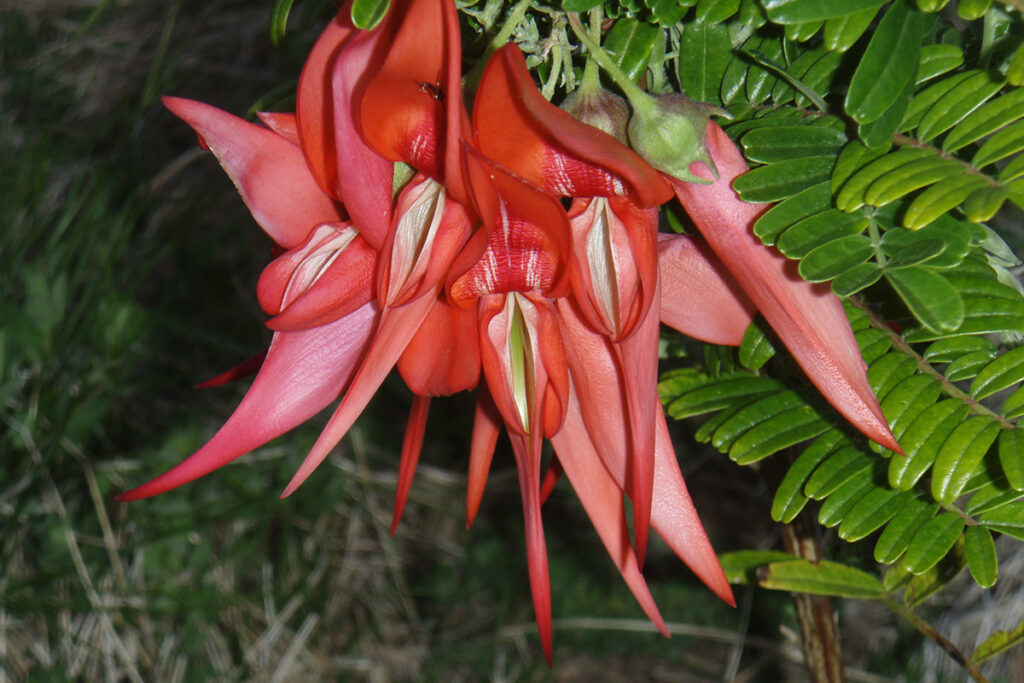Hundreds of wild kākābeak, or ngutukākā have been prevented from being buried in silt from Cyclone Gabrielle by a timely decision from conservationists and volunteers before the cyclone hit.
More than 1,000 specimens of the glorious but near-extinct wild kākābeak, or ngutukākā, were distributed widely across Hawke’s Bay to schools, marae and gardens across the district – just months before a plant nursery at the centre of the national campaign to save the kākābeak was inundated by three meters of floodwater during Cyclone Gabrielle.
Plant Hawke’s Bay, owned and run by well-known biodiversity champion Marie Taylor, was buried in 10-20cm of silt, along with two-thirds of the adult plants from which the distributed plants were propagated and an important collection of seed from wild-grown kākābeak.
Kākābeak is a plant of special significance to New Zealand.

There are two species, both seriously threatened with extinction in the wild: Clianthus puniceus and Clianthus maximus. Its conservation status is Nationally Critical and is found only in New Zealand, with its closet relative in Australia.
There are only about 100 kākābeak plants known to exist in the wild.
One of the founders of the Urban Kākābeak Project and of Redaxe Forestry Intelligence James Powrie said they were “incredibly” lucky to be able to distribute so many young plants, descendants of wild stock that came from wild seed, before Gabrielle hit.
Much of the wild seed used to propagate the 50 plants destroyed at Plant Hawke’s Bay, and the more than 1,000 young plants distributed across the region by The Urban Kākābeak Project, came from the country’s largest plantation of wild kākābeak.
This has been established in three protected enclosures by the Forest Lifeforce Restoration Trust on its property in the Maungataniwha Native Forest in inland Hawke’s Bay.
Most of the 140 plants there survived the damage caused by Cyclone Gabrielle. They are grown from seed collected from bluffy strongholds near the property, and tended by James Powrie, his wife Anita and a team of volunteers.
Seed and cuttings from these plants were, in turn, used by Marie Taylor to establish the population at Plant Hawke’s Bay.
“That’s how we can trace back the genetics of the 1,000-plus plants distributed to safe places across Hawke’s Bay before the floods,” James Powrie said.
“What we have now, thank goodness, are hundreds of little Noah’s Arks for kākābeak spread right across Hawke’s Bay.”
Some of the kākābeak propagated at by both Forest Lifeforce Restoration Trust and Plant Hawke’s Bay are planted back into parts of the Maungataniwha Native Forest where pest control is undertaken.
But these young plants are still subject to predation, so The Urban Kākābeak Project exists to provide many more protected sites, to educate the public and build a community around the plant.
‘Safe sites’ developed by the project include marae around the region; home gardens; Kimi Ora, Iona and Frimley schools in Hastings; a Meridian Energy site in Taupo and a Moteo farm owned by Matt Wilson.
Ultimately the offspring from plants now being raised safely by the project team will be used to restock the nursery at Plant Hawke’s Bay and planted back in the wild, in areas that have been cleared of pests and predators.
Department of Conservation’s Ngutukākā Recovery Group focuses on protecting known wild plants, finding and enhancing new populations and establishing Ngutukākā in the wild in its natural habitat.
Different methods for this include:
Working with iwi and community groups such as Forest Lifeforce Restoration Trust and Scion supporting each other along with farmers, foresters and local business to ensure its survival in the wild and within its natural range.
The East Cape, north of Gisborne, Ruatoria has an extensive roadside planting programme which was established with local schools; including an ingenious method of protecting plants in the wild using animal repellent sprays.
Seed from wild plants in Hawke’s Bay have been collected and propelled onto steep bluffs and inaccessible sites, where browsing animals are unable to reach. Using a hydro-seeding method, the seed is propelled from a helicopter, enabling up to 80,000 seeds at a time to be returned to the wild. No concrete evidence has been recorded to date, but experts are hopeful in five to 10 years, bluffs and cliffs will be flourishing with red Ngutukākā flowers in its natural habitat.
Public Interest Journalism funded by NZ on Air


Excellent! Unfortunately, our kākābeak did not survive the flood….We will try to replace it as soon as we get the chance.
There is a kakabeak growing by the shed leading into the Menzshed at the Hastings Show grounds. I have grown mine from this one’s seeds.
Jan, that plant you’re talking about is from these wild strains that are referred to in the article, FYI
Great stuff. Forest Lifeforce Restoration Trust are doing amazing mahi
A few years ago I purchased a young Kākābeak plant from a local nursery near Napier, and I planted it in my garden. It’s huge now and flowering so beautifully!
I’m relieved that it survived Cyclone Gabriel. It’s so beautiful!
I’m keen to help by adopting a young plant and nurturing it until such time that it can be planted in a protected spot in the wild.